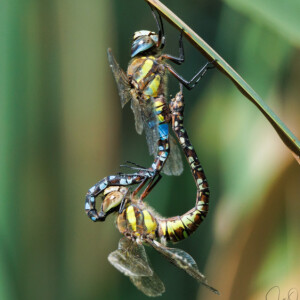Autumn romance redux
I know it's only a few days since I posted another pair of Migrant Hawkers in cop, but you can never see too many Odonata mating wheels, amirite? This pair was rather more battered than the couple I spotted in Stratford last week, but they were in a much better position for photography, in a reed bed next to the carriage splash pool at NT Croome, and I had pretty much 120° access from which to choose my preferred shooting angle.
I've gone with this image, out of many, because it nicely highlights the male's grip on the female's head, which is something you can't always see quite this well. As in all dragonfly species he has three anal appendages called claspers - two above and one below - with which he grasps the top of the female's head to initiate copulation. In order to achieve a mating wheel he has to bend his abdomen around, so it's the inferior appendage you can see here gripping the top of his partner's head, along the suture between her eyes, while the two superior appendages are hooked over the back of her head.
The appendages have tiny teeth to improve grip, and can sometimes cause damage to a female's eyes - though this isn't the worst thing that can happen when an attempted copulation goes wrong. A couple of years ago in Shropshire I saw a male Common Hawker drag the head half off an ovipositing female, who unwisely resisted his attempts to lift her from the rushes to which she was clinging. My distant photos of this gruesome event are still on the Shropshire Dragonflies site, if you have the stomach for them.
My second photo shows the business end of the mating wheel, if I can put it so indelicately. A male dragonfly has two sets of genitalia, the primary set below his eighth abdominal segment, and a secondary set below the second segment. Prior to mating he transfers a sperm packet from the primary to the secondary genitalia, which consist of a pair of lateral hooks called hamules and an opening containing the penis. When a receptive female bends up her abdomen to meet the male's, their genitalia interlock and the male is able to transfer his sperm packet to the female's sperm receptacle. Before doing this though, he uses his penis to clean out her spermatheca, to ensure that it's his sperm rather than that of any previous partner that fertilises her current batch of eggs. Different species of Odonata have slightly different mechanisms for removing rivals' sperm, but it's been stated that whatever the precise process, it takes up the bulk of the time spent in copulation.


Comments
Sign in or get an account to comment.


